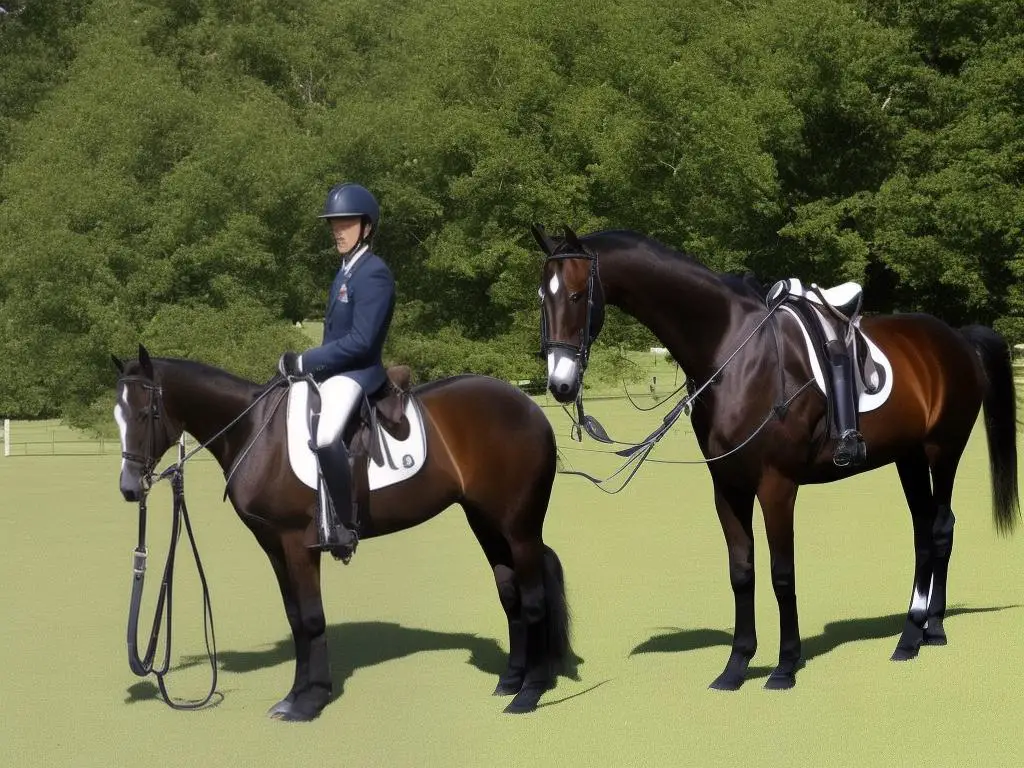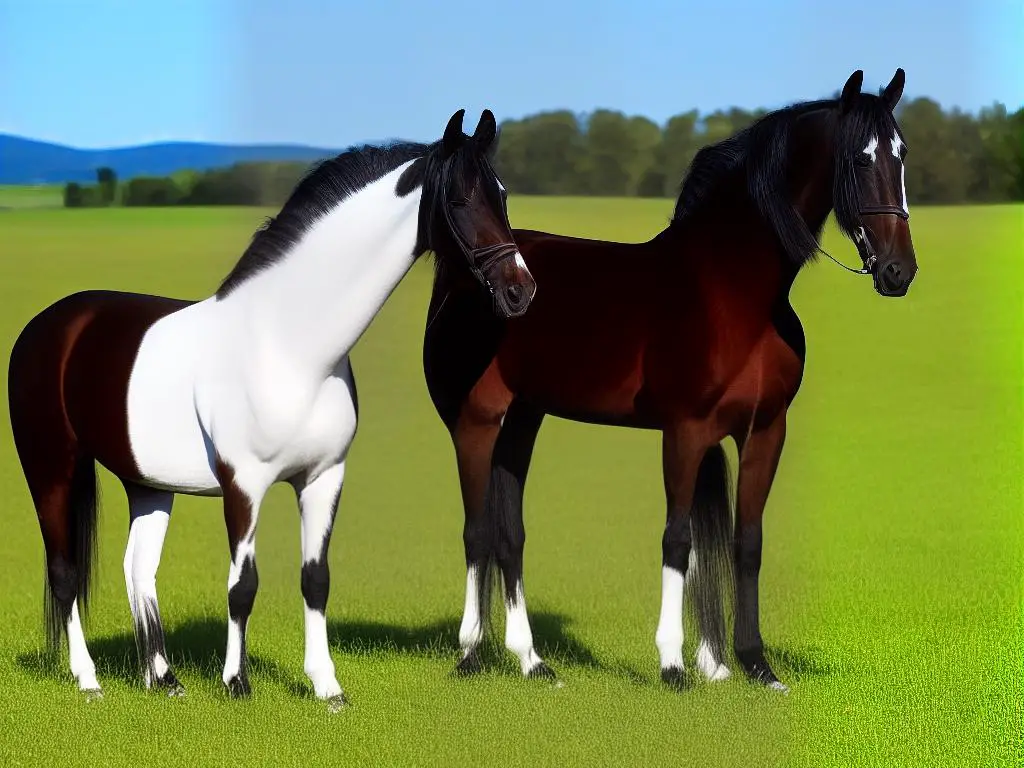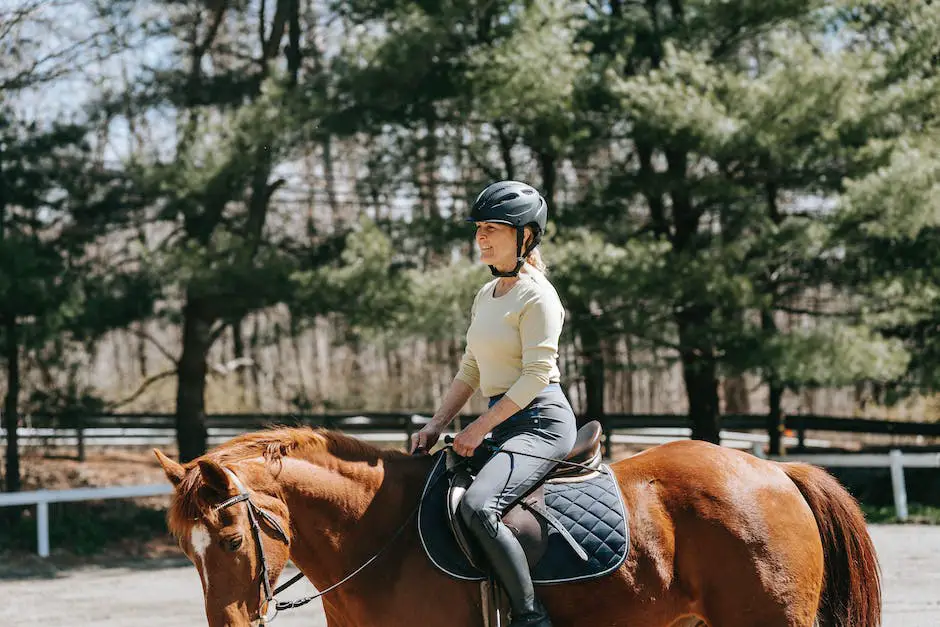Welcome to the exciting world of Saddlebred show clothing and tack! In this article, we’ll take you on a journey through the essential aspects of this fascinating niche, ranging from understanding the various types of clothing and tack to mastering grooming techniques and knowing the specific requirements for different show classes.
Table of Contents (Horspedia)
Understanding Saddlebred Show Clothing
Saddlebred show riders have a variety of clothing options depending on the specific show class they are participating in. Pleasure riding classes, for instance, require riders to wear conservative attire. A traditional look would include a saddle seat riding suit, which consists of a tailored coat and jodhpur pants, a dress shirt, a coordinating tie, gloves, and a derby or soft hat. The chosen colors for pleasure riding class generally include navy, black, or dark green for the suit, and a white shirt. Riders must remember that the main goal of this class is to demonstrate a pleasant and enjoyable ride, so it is important to choose clothing that is both attractive and comfortable.
In equitation classes, riders are judged on their form and riding ability, rather than the horse’s performance. Therefore, it is crucial for riders to wear appropriate attire that showcases their skill and proficiency. Similar to pleasure riding classes, a saddle seat suit is worn, along with tall riding boots, a vest, and a hard hat or helmet for safety. For female riders, a neatly arranged bun with a hairnet is a must, while male riders should ensure their hair is neatly trimmed and combed. The riders’ attire should not distract from their performance, so it is important to choose colors and patterns that are elegant, yet conservative.
Performance classes for Saddlebred show horses emphasize a formal and traditional appearance. Riders are required to wear a tuxedo-style tailcoat, white dress shirt, white gloves, black or navy jodhpur pants, white or black vest, a bow tie, and a top hat for these events. These competitions celebrate the Saddlebred horse’s performance and athleticism, and the rider’s attire reflects the prestige and formality of the occasion. It is crucial for riders to ensure proper fit for their show clothing, as ill-fitted attire can cause discomfort during the performance and may even affect the horse’s presentation. Attention to detail and proper fit are essential in conveying a polished and professional appearance in all classes.

Selecting the Perfect Tack
Selecting the Perfect Tack for Saddlebred Show Competitions
Choosing the right tack for Saddlebred show competitions is crucial to ensure the comfort and safety of both the horse and rider. The saddle is the foundation of the tack, and selecting the appropriate type and size is vital for the rider’s performance. Types of saddles include the cutback or flat, which are typically used in Saddlebred shows as they highlight the horse’s high-motion gaits. A properly fitted saddle is also necessary to avoid discomfort and injury.
Bridles are another essential piece of tack, and the Weymouth or double bridle is the most common choice. This style has two bits – a snaffle and a curb – which give the rider greater control and precision when communicating with the horse. Choosing the correct size and adjusting the fit is crucial to ensure that the bridle is secure.
Girths are also vital in keeping the saddle in place and preventing it from slipping. They come in various styles and materials, including leather, synthetic, and fleece-lined for added comfort. Adequate fit is also necessary to maintain the saddle’s position during the show.
Martingales, breastplates, and cruppers are other important accessories in Saddlebred show tack. Martingales help to control a horse’s head carriage and prevent them from raising their head too high, while breastplates keep the saddle from sliding back. Cruppers prevent the saddle from sliding forward, and each of these accessories should be carefully selected to match the horse’s size and anatomy, ensuring they do not cause discomfort or hinder their movement during the show.
Ultimately, selecting the perfect tack improves the horse’s overall show performance and contributes to their comfort and wellbeing.

Proper Show Grooming Techniques
Proper Show Grooming Techniques for Saddlebred Horses
As a complement to selecting the perfect tack, grooming a Saddlebred horse properly is crucial to showcase its natural beauty and elegance in the show ring. The following tips can help enhance the horse’s appearance and ensure it performs at its best:
- Thoroughly wash the coat with a mild shampoo, paying special attention to the mane, tail, and any white markings
- Use a conditioner or shine-enhancing spray for an extra glossy finish
- Carefully trim excess hair around the face, ears, muzzle, and legs for a neat and tidy appearance
By investing time and effort in proper grooming and selecting the right tack, you are setting your Saddlebred horse up for success in the show ring, allowing them to be presented in the best light possible while ensuring their comfort and safety.
Braiding Techniques for Saddlebred Horses
Braiding is an essential aspect of show grooming for Saddlebred horses. Here are some tips for mane and tail braiding:
- Traditional button or running braids work well for the mane
- Use a false tail or tail extension to create the illusion of a fuller, more balanced tail
- Braid or wrap the tail for protection and cleanliness before a show
- Be aware of specific braiding requirements for different classes or divisions
Show Clothing and Tack for Saddlebred Horses
To truly appreciate and excel in Saddlebred showmanship, enthusiasts must familiarize themselves with the specific show clothing and tack requirements for both horse and rider. In Saddlebred competitions, various show classes and categories dictate these requirements, including performance, pleasure, equitation, and in-hand classes.
Common pieces of tack used in these Saddlebred competitions include:
- A double bridle with a curb and snaffle bit
- A patent leather browband and cavesson
- An elegant-cut back show saddle
- A colorful, contrasting saddle pad
- A martingale to prevent the horse from raising its head too high
Properly maintaining and fitting the horse’s tack is integral to making a good impression in the show ring and keeping the focus on the horse’s beauty and athleticism.

Understanding Show Class Requirements
With a wealth of classes and guidelines to follow, it is crucial for Saddlebred enthusiasts and hobbyists to understand the specific dress, tack, and grooming standards that apply to each show category. These guidelines serve to accentuate the horse’s natural grace, highlight the rider’s presentation skills and emphasize their mutual abilities. By adhering to these requirements, participants can ensure a successful and enjoyable experience, showcasing the true essence of what Saddlebred showmanship is all about.
Performance Classes
Performance classes are focused on the demonstration of the horse’s abilities and talent, requiring riders to finely display their horsemanship skills. For these classes, riders typically wear conservative colors for their attire, such as navy or black suits with a matching derby or soft hat. Riders must have well-polished boots, white or tan breeches, and properly fitted gloves to complete the formal look. The tack, including the saddle, bridle, and saddle pad should be of high quality, clean, and well-fitting. Show grooming is essential in these classes, ensuring the horse’s mane is clipped, the tail is braided, and feathers are trimmed.
Equitation Classes
Equitation classes evaluate the rider’s skill and effectiveness in communicating with the horse while demonstrating correct riding techniques. In these classes, more emphasis is placed on the rider rather than the horse. Riders should opt for traditional and understated attire, such as dark-colored jackets, white or pastel-colored shirts, and black or brown leather boots. Tack should be clean and well-maintained, with saddles and bridles that are appropriate for the specific class, such as a double bridle or a full bridle. Attention to detail in grooming is crucial for these classes, showcasing superbly brushed coats, clipped and thinned manes, and evenly trimmed hooves that complement the overall appearance. Adhering to show rules and guidelines ensures a seamless presentation during the competition, allowing judges to focus on evaluating the rider and horse’s skills without any distractions.

Caring for and Maintaining Show Clothing and Tack
To ensure a successful performance in equitation classes, it is essential to care for and maintain Saddlebred show clothing and tack, preserving their quality, appearance, and longevity. Show clothes are often intricate and made of delicate materials, while tack, including saddles, bridles, and other leather goods, can be susceptible to damage if not properly maintained. One of the most critical aspects of caring for these items is ensuring they are kept clean and free of dirt, sweat, and dust.
Show clothing should be washed or dry-cleaned according to the manufacturer’s instructions and always be allowed to air-dry to prevent damage caused by heat. Tack should be wiped down with a damp cloth after each use to remove sweat and grime, and then be conditioned regularly using leather care products specifically designed for equestrian equipment. By taking proper care of your Saddlebred show clothing and tack, you will ensure a seamless and polished presentation during equitation classes, allowing judges to focus solely on evaluating your skills and your horse’s performance.
Proper storage of Saddlebred show clothing and tack is crucial to protecting them from damage when not in use. Show clothing should be kept in garment bags during transportation and stored in a cool, dry area. Avoid folding show clothing to prevent creasing or wrinkling, and instead, use padded hangers to maintain their shape. Tack should be stored in a clean, climate-controlled space to prevent mold and mildew growth and away from direct sunlight to avoid fading or drying out the leather.
Regularly inspect your tack for signs of wear or damage, paying close attention to stitching, buckles, and billets. Any damaged tack should be repaired or replaced immediately to ensure your horse’s safety and performance during the show.
In addition to routine cleaning and storage, it’s essential to give your Saddlebred show clothing and tack an occasional deep cleaning to keep these items looking their best. Thoroughly clean your tack with saddle soap and a soft brush, paying special attention to crevices and hard-to-reach areas. Apply a high-quality leather conditioner to restore suppleness and shine to the leather, then buff with a soft cloth. Be cautious with the use of oil, as excessive oil can weaken the leather.
For show clothing, use specialized stain removers as needed and consider professional cleaning services for particularly stubborn stains or heavily soiled garments. Taking the time to care for and maintain your Saddlebred show clothing and tack will ultimately enhance your overall show experience and promote a polished, professional appearance in the show ring.

Photo by kellysikkema on Unsplash
By following the guidelines and tips discussed in this article, you’ll be well on your way to becoming proficient in Saddlebred show clothing and tack. Remember, choosing the appropriate attire, tack, and grooming techniques can have a significant impact on your performance in the show ring. Keep learning and practicing, and soon you’ll be turning heads in the Saddlebred show world with your impeccably dressed horse and expertly selected tack!
